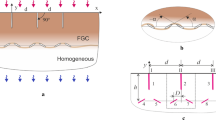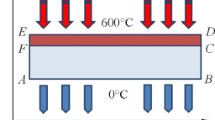Abstract
The plane strain elasticity problem for a functionally gradient material (FGM) and a multi-layered homogeneous coating bonded to a metal substrate due to a uniform temperature change is considered. The substrate is assumed to be a nickel-based alloy-Rene-41. The FGM coating is a particulate composite of Rene-41 and zirconia with volume fractions continuously varying through the thickness. The multi-layered coating consists of one, two or four homogeneous layers with stepwise changing volume fractions. With a possible failure mechanism of surface cracking or edge debonding in mind, the relevant stresses on the surface of the coating and along the interfaces are evaluated. For the piecewise homogeneous coating the power of singularity and the corresponding stress intensity factors at the points of intersection of the interfaces and the free ends are calculated. It is shown that by using the FGM coating the stress singularities are eliminated and the stress distribution is smoothed considerably. Sample results for the displacements and for the contour plots of an effective stress governing the yield behavior of the material are given and the asymptotic behavior of the stress state around the singular point is examined.
Similar content being viewed by others
References
A.P. Batakis and J.W. Vogan, Rocket Thrust Chamber Thermal Barrier Coatings, NASA Contract Report 1750222 (1985).
D.L. Houck (ed.), Thermal Spray: Advances in Coatings Technology, Proceedings of the National Thermal Spray Conference, ASM International (1987).
T. Hirano and T. Yamada, Multi-Paradigm Expert System Architecture Based Upon the Inverse Design Concept, International Workshop on Artificial Intelligence for Industrial Applications, Hitachi, Japan, May 25–27 (1988).
T. Hirano, T. Yamada, J. Teraki, M. Niino and A. Kumakawa, A Study on a Functionally Gradient Material Design System for a Thrust Chamber, Proceedings of the 16th International Symposium on Space Technology and Science, Sapporo, Japan (1988).
M. Niino and S. Maeda, Recent Development Status of Functionally Gradient Materials, I.S.I.J. International 30 (1990) 699–703.
M. Yamanouchi, M. Koizume, T. Hirai and I. Shiota (ed.), FGM-90, Proceedings of the 1st International Symposium on Functionally Gradient Materials, FGM Forum, Sendai, Japan (1990).
J. Holt, M. Koizumi, T. Hirai and Z. Munir (eds.), in Ceramic Transactions, Proceedings of the 2nd International Symposium on Functionally Gradient Materials 34 (1992).
A. Kawasaki and R. Watanabe, in FGM-90, Yamanouchi et al. (eds.), Sendai, Japan (1990) 197–202.
K. Kokini and Y. Takeuchi, in FGM-90, Yamanouchi et al. (eds), Sendai, Japan (1990) 31–36.
M. Case and K. Kokini, in Ceramic Coatings, K. Kokini (ed.), The 1993 ASME Winter Annual Meeting, New Orleans, Louisiana, MD-Vol. 44 (1993) 149–162.
F. Erdogan, ASME Journal of Applied Mechanics 32 (1965) 403–410.
F. Erdogan and V. Biricikoglu, International Journal of Engineering Science 11 (1973) 645–766.
R.L. Williamson and B.H. Rabin, in Ceramic Transactions, Proceedings of the 2nd International Symposium on Functionally Gradient Materials, Holt et al. (eds.), 34 (1992).
F. Erdogan and B.H. Wu, in Ceramic Transactions, Proceedings of the 2nd International Symposium on Functionally Gradient Materials, Holt et al. (eds.) 34 (1992).
F. Erdogan and Y.F. Chen, in Ceramic Transactions, Proceedings of the 2nd International Symposium on Functionally Gradient Materials, Holt et al. (eds.) 34 (1992).
Y.F. Chen, The Interface Crack Problem in Nonhomogeneous Bonded Materials of Finite Thickness, Ph.D. dissertation, Lehigh University (1990).
K. Huebner and E. Thornton, The Finite Element Methods for Engineers, 2nd ed., John Wiley & Sons (1982).
E. Hinton and D. Owen, An Introduction to Finite Element Computations, Pineridge Press, UK (1979).
K.J. Bathe, Finite Element Procedures in Engineering Analysis, Prentice-Hall (1982).
F. Delale and F. Erdogan, International Journal of Engineering Science 28 (1988) 559–568.
F. Erdogan, A.C. Kaya and P.F. Joseph, ASME Journal of Applied Mechanics 58 (1991) 410–418.
F. Erdogan, A.C. Kaya and P.F. Joseph, ASME Journal of Applied Mechanics 58 (1991) 419–427.
Takashi Ishikawa, in FGM-90, Yamanouchi et al. (eds.), Sendai, Japan (1990) 11–16.
Richard M. Christensen, Journal of the Mechanics and Physics of Solids 38 (1990) 379–404.
Y. Benveniste, in Mechanics of Materials 6 (1987) 147–157.
Author information
Authors and Affiliations
Rights and permissions
About this article
Cite this article
Lee, YD., Erdogan, F. Residual/thermal stresses in FGM and laminated thermal barrier coatings. Int J Fract 69, 145–165 (1994). https://doi.org/10.1007/BF00035027
Received:
Accepted:
Issue Date:
DOI: https://doi.org/10.1007/BF00035027




